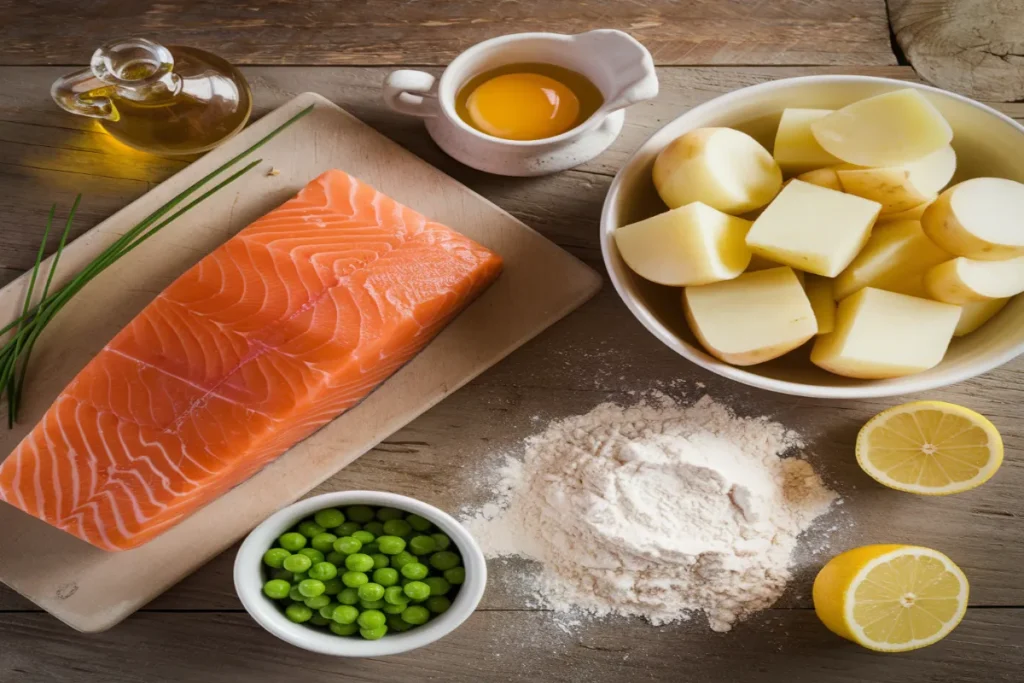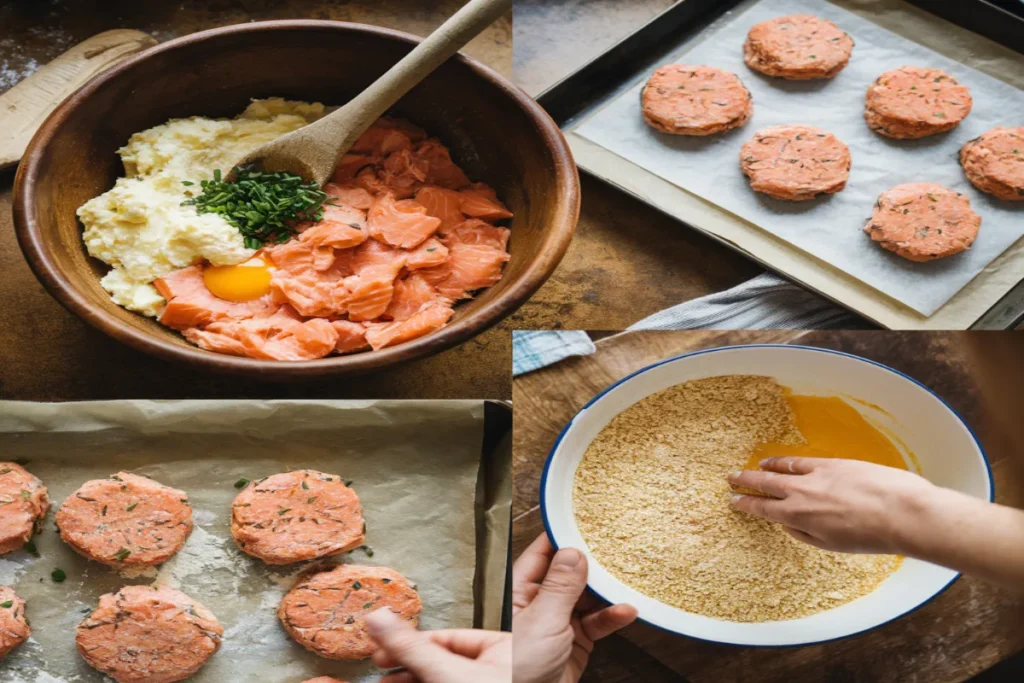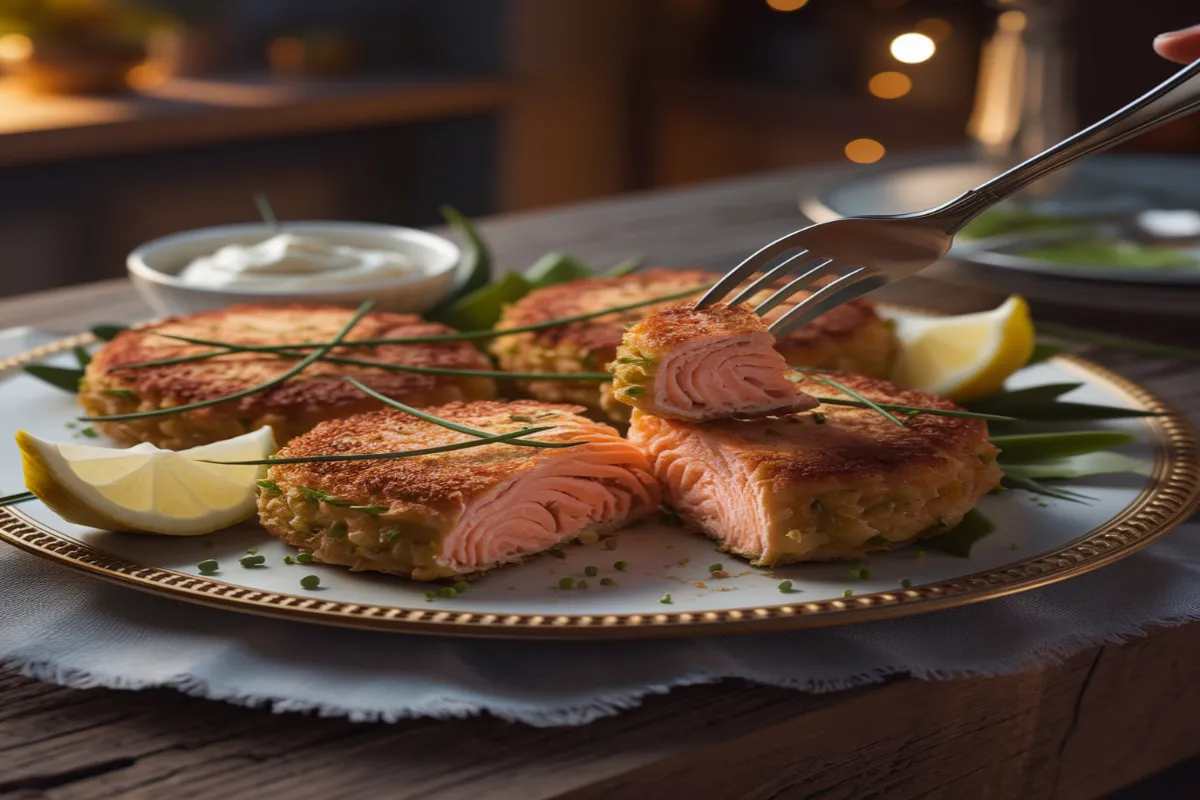Picture this: it’s midweek, and you’re juggling work, family, and a never-ending to-do list. The thought of cooking feels overwhelming, but you’re craving something hearty and homemade. That’s where my salmon fish cakes recipe comes in—a lifesaver for busy evenings!
I’ve designed this dish to be quick, simple, and packed with flavour. Using fresh ingredients and pantry staples, you can whip up a satisfying meal in no time. Whether you’re cooking for one or feeding a family, these fishcakes are a crowd-pleaser.
Ready to get started? Let’s dive into the details and make your next dinner a breeze!
Table of Contents
Introduction
Busy evenings call for meals that are as easy as they are delicious. That’s exactly what inspired this dish—a blend of tradition and modern shortcuts. Using fresh salmon and a handful of simple ingredients, I’ve created a recipe that’s perfect for busy home cooks.
This fishcake recipe is designed to fit seamlessly into your hectic schedule. It’s quick to prepare, taking just a few minutes, yet it delivers a gourmet experience. Whether you’re cooking for yourself or feeding a family, this dish is a winner.
Recipe Background and Inspiration
The idea for this recipe came from a love of chilled fishcake mixtures. I wanted to create something that was both comforting and convenient. Using fresh salmon ensures a rich, satisfying flavour, while the simple steps make it accessible to everyone.
Why This Recipe is Perfect for Busy Home Cooks
Life can be chaotic, but dinner doesn’t have to be. This fishcake recipe is a lifesaver for those evenings when time is tight. It’s kid-friendly, making it ideal for family dinners, and the ingredients are easy to find. Plus, it’s packed with nutrients, so you can feel good about what you’re serving.
Ready to dive in? Let’s get started on creating a meal that’s as enjoyable to make as it is to eat!
Essential Ingredients and Pre-prep

Every great meal starts with quality ingredients—here’s what you’ll need. This dish combines fresh and pantry staples to create a flavourful and satisfying experience. Let’s break it down so you’re fully prepared before you start cooking.
Fresh and Pantry Ingredients
To make this dish, you’ll need a mix of fresh and pantry items. Here’s a quick rundown:
- Fresh salmon: 500g of skinless fillet ensures a rich, tender texture.
- Potatoes: 350g of Maris Piper potatoes add a creamy base.
- Peas: A handful of peas brings a pop of colour and sweetness.
- Flour: A light dusting helps bind the mixture.
- Egg: One beaten egg acts as a natural binder.
- Oil: A drizzle of oil ensures a crisp finish when frying.
Each ingredient plays a crucial role in creating the perfect balance of flavour and texture.
Pre-preparation Tips
Preparation is key to making this recipe a breeze. Here are some handy tips:
- Chill your ingredients: Cold ingredients help the mixture hold its shape better.
- Peel and boil the potatoes: Start this first to save time later.
- Organise your workspace: Having everything ready before you start makes the process smoother.
- Preheat your oven: If baking, set it to 200°C / 390°F to save time.
With these tips, you’ll be ready to cook with confidence and efficiency.
Step-by-Step Salmon Fish Cakes Recipe
Ready to transform simple ingredients into something extraordinary? Let’s walk through the process of creating these golden, crispy patties. With a few easy steps, you’ll have a dish that’s both satisfying and impressive.
Mixing and Binding the Ingredients
Start by combining your cooked potatoes and flaked fish in a large bowl. Add a tablespoon of chopped chives, a squeeze of lemon juice, and a pinch of salt and pepper. Mix everything gently to avoid breaking up the fish too much.
Next, crack an egg into the mixture. This acts as a natural binder, helping everything stick together. Use your hands to blend it thoroughly, ensuring the mixture is cohesive but not overworked.
Pro Tip: Chill the mixture in the fridge for 10 minutes. This makes it easier to shape and prevents it from falling apart during cooking.
Shaping and Coating the Patties
Once chilled, divide the mixture into equal portions. Use your hands to shape them into smooth, even patties about 2cm thick. If the mixture feels sticky, lightly dust your hands with flour.
For the perfect crust, follow the three-stage coating process:
- Dust each patty lightly with flour.
- Dip it into a beaten egg, ensuring it’s fully coated.
- Press it into breadcrumbs, covering all sides evenly.
Handy Tip: Use one hand for wet ingredients and the other for dry to avoid clumping. If breadcrumbs stick to your fingers, rinse and dry your hands between patties.
| Step | Time | Tips |
|---|---|---|
| Mixing | 5 minutes | Chill for better binding |
| Shaping | 10 minutes | Dust hands with flour |
| Coating | 15 minutes | Use separate hands for wet and dry |
With these steps, you’re well on your way to creating the perfect fishcake. Now, let’s move on to cooking methods to bring out their best flavour!

Cooking Methods and Techniques
When it comes to cooking, the method you choose can make all the difference. Whether you’re after a crisp finish, a healthier option, or a fuss-free approach, there’s a technique to suit your needs. Let’s explore the three main methods: frying, baking, and air-frying.
Frying, Baking, or Air-Frying: Making the Right Choice
Each cooking method has its own benefits. Frying gives you that golden, crispy exterior we all love. Baking is a simpler, hands-off approach, while air-frying offers a healthier alternative without sacrificing texture. Here’s a breakdown to help you decide:
- Frying: Heat a drizzle of oil in a pan over medium-high heat. Cook each side for about 5 minutes until golden and crisp. Perfect for a quick, indulgent meal.
- Baking: Preheat your oven to 200°C / 390°F. Place the patties on a lined tray and bake for 15-20 minutes. Ideal for a fuss-free option.
- Air-Frying: Set your air fryer to 180°C / 350°F. Cook for 10-12 minutes, flipping halfway. A healthier choice with a crispy finish.
“The right cooking method can turn a simple dish into a masterpiece.”
Here’s a quick comparison to help you choose:
| Method | Time | Heat | Texture |
|---|---|---|---|
| Frying | 10 minutes | Medium-high | Crispy |
| Baking | 15-20 minutes | 200°C / 390°F | Soft with a slight crust |
| Air-Frying | 10-12 minutes | 180°C / 350°F | Crispy and light |
Whichever method you choose, keep an eye on the heat to avoid overcooking. A golden-brown exterior with a tender centre is the goal. Happy cooking!
Tips, Variations and Substitutions
Cooking is all about flexibility—here’s how you can make this dish your own. Whether you’re looking to enhance the flavour or adapt it to different tastes, these tips and swaps will inspire you to get creative in the kitchen.
Enhancing Flavour with Substitutions
Want to add a personal touch? Try these simple swaps to elevate the dish. Swap regular breadcrumbs for panko for a crispier texture. Add a squeeze of lemon zest for a fresh, zesty kick. If you’re out of fresh herbs, dried ones work just as well—use 1 teaspoon for every tablespoon of fresh.
For a richer flavour, mix in a dollop of sweet chilli sauce or a pinch of chilli flakes. These small changes can make a big difference, giving your meal a unique twist.
Creative Variations for Different Palates
This dish is incredibly versatile. If you’re not a fan of salmon, try using tinned tuna instead. It’s just as delicious and works perfectly in this recipe. For a gluten-free option, substitute regular flour with oat flour.
Want to make it spicier? Add extra chilli flakes or a dash of hot sauce. You can also double the recipe and freeze the leftovers for a quick meal later. Simply thaw and reheat in the oven or air fryer for a crispy finish.
| Ingredient | Substitution | Effect |
|---|---|---|
| Breadcrumbs | Panko | Crispier texture |
| Salmon | Tuna | Rich, savoury flavour |
| Flour | Oat flour | Gluten-free option |
| Chilli flakes | Hot sauce | Spicier kick |
| Fresh herbs | Dried herbs | Convenient alternative |
With these tips and variations, you can make this dish truly your own. Experiment, have fun, and enjoy the process of creating something uniquely delicious!

salmon fish cakes recipe
Ingredients
Equipment
Method
- Prepare Ingredients: Boil the potatoes until soft, then mash and let them cool. Flake the salmon and add to a large mixing bowl.
- Mix Ingredients: Add the mashed potatoes, peas, chives, lemon juice, salt, and pepper to the salmon. Mix gently.
- Bind the Mixture: Stir in the beaten egg and a tablespoon of flour. Mix well but avoid overworking.
- Chill the Mixture: Refrigerate for 10 minutes to help it hold shape.
- Shape Patties: Divide the mixture into equal portions and form into patties, about 2cm thick.
- Coat Patties: Lightly dust each patty with flour, dip in beaten egg, and coat with breadcrumbs.
- Cooking Options:
- Frying: Heat oil in a pan over medium-high heat. Fry each patty for 5 minutes per side until golden and crispy.
- Baking: Preheat oven to 200°C / 390°F. Bake for 15-20 minutes on a lined baking sheet.
- Air-Frying: Set air fryer to 180°C / 350°F and cook for 10-12 minutes, flipping halfway.
- Serve and Enjoy: Serve hot with a side of salad, tartar sauce, or lemon wedges.
Frequently Asked Questions
How do you keep salmon cakes from falling apart?
To keep salmon cakes from falling apart, use a good binder like eggs and breadcrumbs. Make sure the mixture isn’t too wet—if it is, add more breadcrumbs or a little flour. Chilling the patties for 20–30 minutes before cooking helps them hold their shape. Also, avoid flipping them too early; let them cook until they form a crust before turning.
What are the ingredients in salmon cakes?
Classic salmon cakes usually include:
Salmon (fresh, canned, or leftover)
Binder (egg, mayo, or mustard)
Filler (breadcrumbs, panko, or crushed crackers)
Seasonings (salt, pepper, garlic powder, paprika, or Old Bay)
Mix-ins (chopped onions, parsley, bell peppers, or celery)
Cooking fat (oil or butter for frying)
How do you bake Mary Berry salmon?
Mary Berry’s salmon recipes often involve simple seasoning and gentle baking. To bake salmon her way:
Preheat oven to 375°F (190°C).
Season salmon with salt, pepper, lemon juice, and fresh herbs like dill.
Place on a baking sheet lined with parchment paper.
Bake for 12–15 minutes, depending on thickness, until just flaky.
Serve with a light sauce like crème fraîche with lemon and dill.
What is the binder for fish cakes?
The binder is what holds fish cakes together. Common binders include:
Eggs (the most effective option)
Mayonnaise (adds moisture and binding)
Mustard (for extra flavor and binding power)
Breadcrumbs or crushed crackers (helps absorb excess moisture)
Mashed potatoes (used in some styles of fish cakes)
Why are my fish cakes soggy?
Fish cakes can turn out soggy if there’s too much moisture. Here’s how to fix it:
Drain canned or cooked salmon well before mixing.
Avoid too much mayo or wet ingredients.
Use enough breadcrumbs to absorb extra moisture.
Chill the mixture before frying to firm it up.
Cook at the right heat—too low, and they’ll absorb oil instead of crisping up.
How do you cook salmon so it doesn’t fall apart?
To keep salmon from falling apart while cooking:
Pat it dry before seasoning to remove excess moisture.
Cook on medium heat to prevent breaking from high-heat shocks.
Use a fish spatula (thin and wide) for flipping.
Bake or air-fry instead of pan-frying for a gentler cooking method.
Let it rest after cooking—this helps it firm up before serving.
